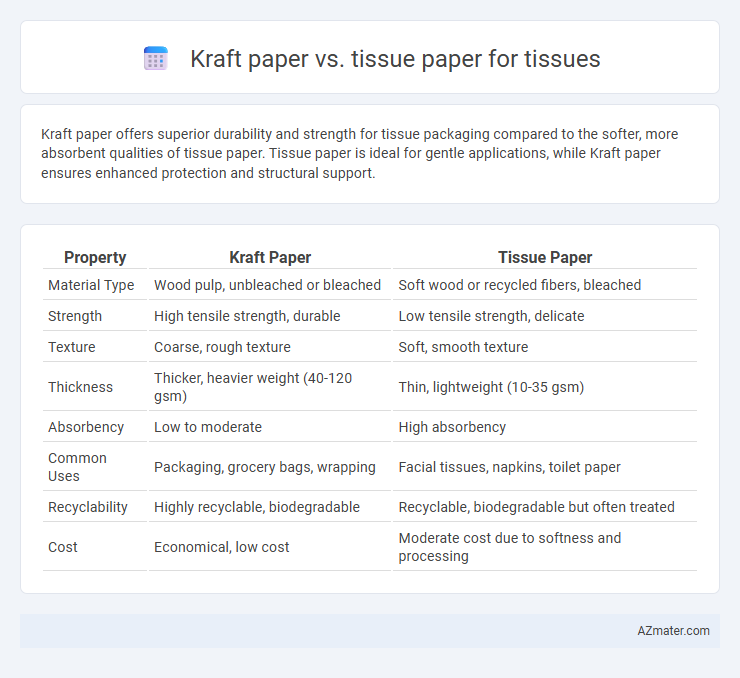Kraft paper offers superior durability and strength for tissue packaging compared to the softer, more absorbent qualities of tissue paper. Tissue paper is ideal for gentle applications, while Kraft paper ensures enhanced protection and structural support.
Table of Comparison
| Property | Kraft Paper | Tissue Paper |
|---|---|---|
| Material Type | Wood pulp, unbleached or bleached | Soft wood or recycled fibers, bleached |
| Strength | High tensile strength, durable | Low tensile strength, delicate |
| Texture | Coarse, rough texture | Soft, smooth texture |
| Thickness | Thicker, heavier weight (40-120 gsm) | Thin, lightweight (10-35 gsm) |
| Absorbency | Low to moderate | High absorbency |
| Common Uses | Packaging, grocery bags, wrapping | Facial tissues, napkins, toilet paper |
| Recyclability | Highly recyclable, biodegradable | Recyclable, biodegradable but often treated |
| Cost | Economical, low cost | Moderate cost due to softness and processing |
Introduction to Kraft Paper and Tissue Paper
Kraft paper is a robust, coarse paper produced from chemical pulp through the kraft process, known for its high tear resistance and durability, making it ideal for packaging and wrapping. Tissue paper, by contrast, is a lightweight, thin, and soft paper commonly made from recycled or virgin pulp, optimized for absorbency and gentle texture, often used in hygiene products and delicate wrapping. Both papers serve distinct purposes in tissue applications, with kraft paper providing strength and protection while tissue paper offers softness and comfort.
Manufacturing Process: Kraft vs Tissue Paper
Kraft paper is produced using the kraft pulping process, which involves chemically digesting wood chips with sodium hydroxide and sodium sulfide to remove lignin, resulting in strong, durable fibers ideal for packaging. Tissue paper manufacturing employs mechanical and chemical pulping methods, combining refined fibers with additives to create a soft, thin, and absorbent material suitable for hygiene products. The fundamental difference lies in kraft paper's strength and coarse texture from chemical pulping, whereas tissue paper emphasizes softness and absorbency through delicate fiber treatment and calendaring.
Material Composition and Properties
Kraft paper is made from wood pulp through the kraft process, resulting in a strong, coarse texture with high durability and tear resistance, ideal for packaging and wrapping applications. Tissue paper, produced from refined wood pulp or recycled fibers, has a soft, thin, and lightweight structure designed for absorbency and gentle use, commonly used in hygiene products and delicate wrapping. The primary difference lies in kraft paper's robustness and thickness versus tissue paper's softness and flexibility, affecting their suitability for different tissue-related uses.
Absorbency and Softness Comparison
Kraft paper boasts high durability and excellent absorbency, making it suitable for heavy-duty tasks but often feels rough on the skin compared to tissue paper. Tissue paper excels in softness and gentle texture, designed for delicate applications like facial tissues, but typically absorbs liquids less efficiently than kraft paper. Selecting between kraft and tissue paper depends on prioritizing either superior absorbency or enhanced softness for specific tissue needs.
Strength and Durability: Kraft vs Tissue Paper
Kraft paper offers superior strength and durability compared to tissue paper, making it ideal for packaging and heavy-duty applications. Its dense fiber composition provides excellent tear resistance and load-bearing capacity, whereas tissue paper is lightweight and prone to tearing under stress. For products requiring protection and long-lasting integrity, kraft paper is the preferred choice over tissue paper.
Environmental Impact and Sustainability
Kraft paper offers superior environmental benefits due to its production from unbleached, recycled wood fibers, reducing chemical use and promoting biodegradability compared to tissue paper. Tissue paper typically involves intensive bleaching and chemical treatments that increase its carbon footprint and decrease recyclability. Choosing kraft paper over tissue paper supports sustainability by minimizing resource consumption and enhancing compostability.
Cost Analysis: Kraft Paper vs Tissue Paper
Kraft paper generally offers lower production costs due to its unbleached, coarse fibers and simpler manufacturing process, making it a cost-effective choice for bulk packaging and industrial uses. Tissue paper, characterized by its softness, thinness, and often bleached or colored variants, incurs higher costs from more refined raw materials and intensive processing required for consumer-grade products. When analyzing cost-effectiveness for tissue applications, tissue paper's premium price is justified by enhanced properties like softness and absorbency, while kraft paper provides durability at a substantially reduced cost.
Applications in the Tissue Industry
Kraft paper is widely used in the tissue industry for packaging due to its strength, durability, and eco-friendly properties, providing protection and support for tissue products during transportation. Tissue paper, on the other hand, is primarily used for consumer-facing applications such as facial tissues, toilet paper, and napkins, prized for its softness, absorbency, and lightweight texture. Both materials play crucial roles in the tissue industry supply chain, with kraft paper enhancing packaging sustainability and tissue paper ensuring end-user comfort and functionality.
Consumer Preferences and User Experience
Consumers prefer kraft paper for tissue packaging due to its durability and eco-friendly appeal, enhancing the unboxing experience with a natural, rustic look. Tissue paper is favored for its softness and smooth texture, providing a gentle touch that improves user comfort during application. The choice between kraft paper and tissue paper significantly impacts brand perception, with kraft paper appealing to environmentally conscious users while tissue paper emphasizes luxury and delicacy.
Choosing the Right Paper for Tissue Production
Kraft paper offers superior strength and durability, making it ideal for tissues requiring enhanced toughness and longevity, while tissue paper excels in softness and absorbency, perfect for delicate skin applications. Selecting the right paper depends on the end-use requirements: kraft paper suits industrial or heavy-duty tissues, whereas tissue paper caters to personal hygiene products prioritizing comfort. Balancing factors like ply count, fiber composition, and intended tissue function ensures optimal performance and user satisfaction.

Infographic: Kraft paper vs Tissue paper for Tissue
 azmater.com
azmater.com